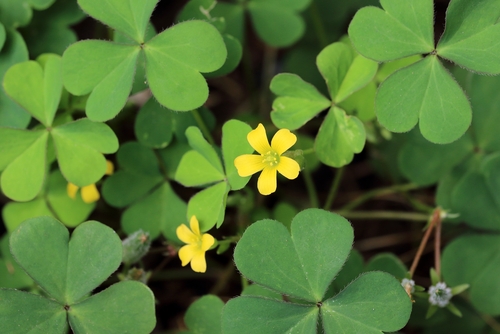Weed Identification at Charles Street Gardens

Oxalis
is a large genus of flowering plants in the wood-sorrel family Oxalidaceae comprising about 570 species. The genus occurs throughout most of the world, except for the polar areas; species diversity is particularly rich in tropical Brazil, Mexico and South Africa.
Many of the species are known as wood sorrels (sometimes written “woodsorrels” or “wood-sorrels”) as they have an acidic taste reminiscent of the sorrel proper (Rumex acetosa), which is only distantly related. Some species are called yellow sorrels or pink sorrels after the color of their flowers instead. Other species are colloquially known as false shamrocks, and some called sourgrasses. For the genus as a whole, the term oxalises is also used.

Cheeseweed, Mallow
Malva parviflora
is an annual or perennial herb that is native to Northern Africa, Europe and Asia and is widely naturalised elsewhere. Common names include cheeseweed, cheeseweed mallow, Egyptian mallow, least mallow, little mallow, mallow, marshmallow, small-flowered mallow, small-flowered marshmallow and smallflower mallow.
M. parviflora leaf extracts possess anti-inflammatory and antioxidant activities. It has a decumbent or erect habit, growing up to 50 cm in height. The broad leaves have 5 to 7 lobes and are 8 to 10 cm in diameter. It has small white or pink flowers with 4 to 6 mm long petals.

Bindweed
Convolvulus arvensis
This is a species of bindweed in the morning glory family (Convolvulaceae), native to Europe and Asia. It is a climbing or creeping herbaceous perennial plant growing to 0.5–2 m high. There are two varieties:
- Convolvulus arvensis var. arvensis. Leaves broader.
- Convolvulus arvensis var. linearifolius. Leaves narrower.
Other common names, mostly obsolete, include lesser bindweed, European bindweed, withy wind (in basket willow crops), perennial morning glory, smallflowered morning glory, creeping jenny, and possession vine.
Field bindweed intertwines and topples native species. It competes with other species for sunlight, moisture and nutrients. It poses threats to restoration efforts and riparian corridors by choking out grasses and forbs. It can decrease habitat biodiversity. It is one of the most serious weeds of agricultural fields in temperate regions of the world.

Little Bittercress
Cardamine oligosperma
Little bittercress is a winter or summer annual (and sometimes biennial) broadleaf. In California, it is considered a desirable floral community member in natural settings, but is sometimes weedy in disturbed places such as landscaped areas, orchards, nurseries, turf, and vegetable crops.
Mature plant
Plants range from 3 to 12 inches (7.5–30 cm) tall, with several branched, smooth stems emerging from the soil line. Leaves radiate from the base of the stem, forming a rosette. Leaves divide into two to five lateral leaflet pairs, and one larger terminal leaflet. Leaflets of rosette leaves are often round to kidney shaped. The upper stem leaflets are narrower than those near base. Leaflet edges are smooth to slightly lobed. Hairy bittercress, Cardamine hirsute, is similar but with fewer, lobed or kidney-shaped leaflets.
Flowers
Flowers bloom from March through July. Two to ten white flowers are found along the stem on stalks of unequal length.
